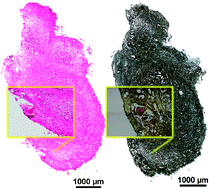Paper – Paraffin removal from FFPE sections
Assessment of paraffin removal from prostate FFPE sections using transmission mode FTIR-FPA imaging
Caryn Hughes, Lydia Gaunt, Michael Brown, Noel W. Clarke and Peter Gardner
Anal. Methods (2014)
Abstract
Formalin-fixed paraffin-embedded (FFPE) tissue sections are routinely analysed for biochemical discrimination by vibrational spectroscopy techniques in the spectral pathology community. In these experiments, it is usually desirable to remove the paraffin from the tissue. This is most commonly performed by the use of xylene but other solvents such as hexane are also used. It is thought that the removal of unbound paraffin wax by such solvents also leaches out lipids native to the tissue, leading to the perception by some that any subsequent analysis on remaining lipids of dewaxed tissue may be unreliable. The scope of the study was to make an assessment of whether a dewaxing protocol can demonstrate that paraffin wax is reliably removed in relation to the detectable limits of transmission mode infrared spectroscopy. In this study, a specific sampling region of two serial FFPE sections of human prostate cancer were analysed by monitoring the methylene hydrocarbon-associated vibrations as a function of solvent immersion time during washes of either hexane or xylene. Results of the study indicate that after 5–10 minutes of immersion in the solvent the hydrocarbon-associated vibrations remain fairly consistent across the tissue. This suggests that while methylene chains of free, unbound tissue lipids are leached from the tissue (assumingly in the first tissue processing stages prior to paraffin embedding) solvent-resistant lipids remain present in formalin-fixed tissue due to being locked into protein–lipid complex matrices, predominantly in the membranes. It is these lipids signals that are subsequently detectable by spectral pathology and may still prove to be of diagnostic use.
